
Miss Alice Mary Burton R.B.A., 40, (1892-1973) painted the portrait of Lady Rhondda presented at the dinner as well as the full length portrait currently hanging in the House of Lords. Alice had been elected a full Member of the Royal Society of British Artists in 1932, the year before the dinner.[2] [3] [4] She also became a member of the Royal Society of Portrait Painters. She has been one of my favourite finds in researching this dinner.
Don’t miss new recollections at the end of this page from a family who have had paintings done by Alice – “stunning portraits, in which she seems to access the soul of the sitter ” ……
SEATED BESIDE
Jane, her dog? More seriously, the ideal dinner partners might have been Cicely Hamilton and Stephen Gwynn, both francophiles. I don’t know how connected Alice felt to France, despite being born there, but perhaps a good conversation may well have set up Cicely, later sitting for Alice, in 1937.
WHAT’S ON HER MIND?
No doubt she would hope that the picture would go down well and perhaps lead to future commissions. We do know that the Chair, Winifred Cullis, who presented the portrait to Lady Rhondda, must have approved as Alice painted her portrait a few years later, in more formal garb but with a human touch.
ALICE’S STORY SO FAR

Alice Mary Burton was born on 21st September 1892 in Nogent-les-Vierges, (now Nogent-sur-Oise), Oise, Picardie, France, the sixth of eight children and the only daughter of Alice Edith Burton, née Hoyle, born in Huddersfield and Charles William Burton, a Notting Hill, London born metals engineer and dealer working in France (whose parents also lived in Paris).[6] As the business prospered they all moved to the turreted Chateau de Retiro, which still has an artistic life as the local concert and arts centre.

Alice studied art at the Byam Shaw and Vicat Cole School of Art (absorbed into Central St Martins in 2003) and at the Regent Street Polytechnic School (achieving Bronze and Silver Medals). She was a portrait and figure painter, although producing a few landscapes, with exhibitions at the ROI, RBA, RA and the Paris Salon.[7] She also painted (later) the portraits of Winifred Cullis, the chair of the dinner and presenter of the painting and of Cicely Hamilton, a “bold painting” exhibited at the Royal Academy in 1937.
In March 1912 a Miss Alice Burton subscribed a shilling to the William Ball Fund, along with, inter alia, Henry Nevinson and Eva Moore. In 1911 William Ball had been in prison for suffrage activities, force-fed, and in 1912 declared insane and released to a lunatic asylum without his wife being told.[8] This may not be our Alice, but it might be: she would have been 19.

In 1924 (January 19th – February 9th) Alice exhibited two paintings at the 34th Annual Exhibition of the Royal Society of Portrait Painters at the Royal Academy: Portrait Sketch and Mrs Ellerby Bell.[9]
Mrs Ellerby Bell, born Lucy Anna Weddell in c 1849 in Berwick on Tweed, the daughter of James Call Weddell, was the widow of James Ellerby Bell, who lost his life, along with another 127 of the 144 passengers and crew, in the sinking of the S.S. Berlin off the Hook of Holland in 1907. It was a major disaster for the time.[10] James Ellerby was born in Moscow and in 1907 was residing in Moscow and in Southborough, Kent. At the time of her death, at least, Lucy Anna lived in Tunbridge Wells (probably with her two unmarried daughters), the home of Alice’s parents, which may account in some way for the commission. In 1911 the widowed Lucy was living at the family home of Mount Sandford, Southborough, Kent, with her 30 year old daughter Ada Lucy: she had 7 children, 3 of who were deceased by 1911.
In the RSPP catalogue, Alice was listed simply as A.M. Burton. Next on the catalogue list was the well-known Welsh portraitist Christopher Williams, one sitter being David Lloyd George.
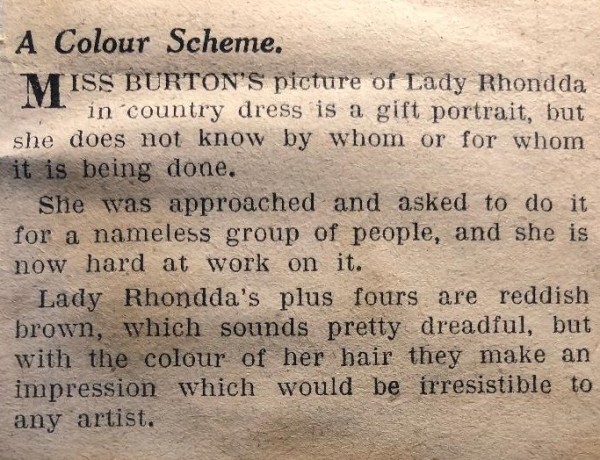
In early 1931 – two years before the dinner – Alice was commissioned to paint Lady Rhondda’s portrait, by whom and for purpose she was not informed. The Hartlepool Northern Daily Mail of 29th May 1931 picked up the story then doing the rounds:
NOVELTY IN WALL DECORATION. Success has soon come to Miss Alice Burton, the artist, who has just been made R.B.A., the only woman to be accorded this honour this year. She also has three pictures in the Paris Salon. Miss Burton is now painting Lady Rhondda in country attire as a presentation portrait. But neither Miss Burton nor Lady Rhondda knows who is presenting it (writes “Mr. Gossip,” in the “Daily Sketch.”) This artist never wastes the paint on her palette. Instead of washing it off she puts it on her walls. “I like that kind of background for my Portraits,” she said. “If one has all the colours of the spectrum on the walls, one’s sitter does not get any reflection.[11]
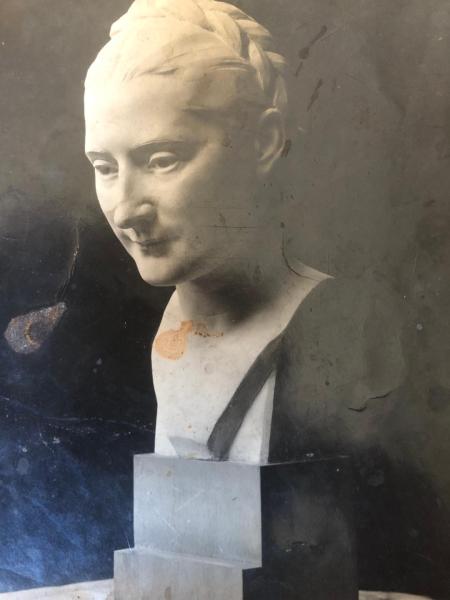
The Daily Sketch was then owned by Sir Gomer Berry. And the Western Mail, another Berry brothers paper, also ran the story.
PORTRAIT OF LADY RHONDDA. Well-kept Secret of a Presentation. Lady Rhondda is having her portrait painted for presentation by Miss Alice Burton, the eminent woman artist, who has had three portraits in the Paris Salon this season. Miss Burton has also just been made an R.B.A., the only woman to be accorded this honour this year. Lady Rhondda visits Miss Burton in her studio in Gloucester Gate, London, for her sittings. “I have no idea who is presenting the portrait to Lady Rhondda. She does not know, either,” Miss Burton told a press representative. ” I was telephoned one morning by someone stated to represent a committee who wished to make this presentation, and I was commissioned to do it.” Miss Burton painted a portrait of Sir Kynaston Studd, one of London’s Lord Mayors, which was exhibited in the Royal Academy.[12]
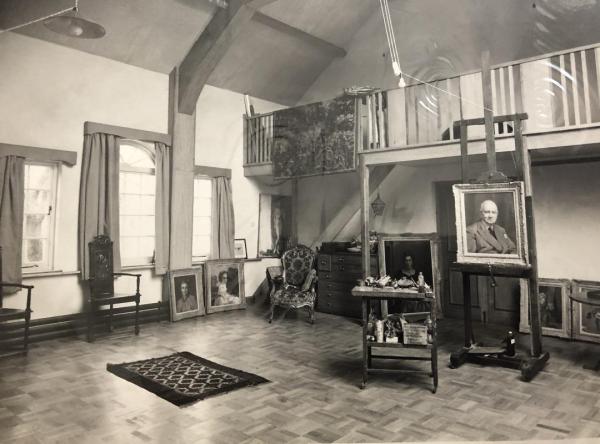
Gloucester Gate perhaps should have read Gloucester Place.
All this suggests that the Berry brothers may well have been partly behind the commission – and they had the wherewithal.
Lady Rhondda’s god-daughter, Francesca Webber (née Conlon), later recalled being at Llanwern, when she was 12, at what was most likely Alice’s first meeting with her sitter for this mystery client: “I felt that Miss Burton was afraid of M, or at least in awe of her” …. quite credible for the up-and-coming 39 year old artist meeting the formidable businesswoman, publisher in her prime. Hence perhaps the importance of painting Lady Rhondda in a relaxed mode, to try to get through to the person behind the grandeur.[13]

After much searching we now have a wonderful set of photographic portraits of Alice herself. Miraculously, the day before the dinner, a photograph was published of her putting the final touches to her portrait of Lady Rhondda, with her dog Jane patiently watching.
“Watched by her dog Jane, Miss A.M. Burton, R.B.A., was yesterday putting the finishing touches to a presentation portrait of Lady Rhondda. Jane sits for hours on a stool beside the easel in the London studio, while her mistress is at work.”[14]
Perhaps someone at the Rembrandt made sure the paint was dry? Now we also know that Alice had a dog.
![]() What is also interesting for us is that Alice painted two versions of this portrait. The other one was quite recently sold to the Museum of Wales in Cardiff, where it now hangs. The third major portrait is the full length one, more formal, also recently acquired by the House of Lords where it now hangs. Both these latter portraits were left by Alice to her nieces in her will. What we don’t know is where the portrait presented at our dinner is! Can you help?
What is also interesting for us is that Alice painted two versions of this portrait. The other one was quite recently sold to the Museum of Wales in Cardiff, where it now hangs. The third major portrait is the full length one, more formal, also recently acquired by the House of Lords where it now hangs. Both these latter portraits were left by Alice to her nieces in her will. What we don’t know is where the portrait presented at our dinner is! Can you help?
WHAT ALICE DID NEXT
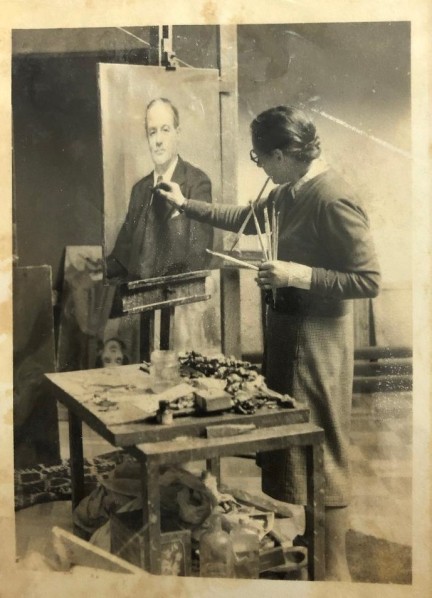
Alice would often paint more than one version of a picture. In June 1933 she was to show her skill in reproducing her work in short order. Commissioned to paint the portrait of the former headmaster of Cheltenham College, it was duly delivered in the autumn of 1932. But in early June 1933 when the painting was unwrapped ahead of the presentation at the end of the month it was found to have been damaged by being pressed against the glass. Requests to repair it were waved away by Alice who in two weeks painted a new one in time for the ceremony. The press report cited a number of the portraits she had done in the past, including that of Lady Rhondda, perhaps a nod at “our” portrait or the more formal one in the House of Lords, painted in 1931, the year she started the informal portrait.[15]
As a member of the RBA Alice’s work now began to appear more regularly:
“Miss Alice Burton’s ‘At the Seventh Time’, one of the most striking figure-landscapes has a conspicuous position ….. in the main gallery” A Royal Academy exhibition, Gloucestershire Echo 17th May 1934
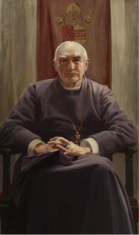
“One finds a ruggedness unexpectedly in Miss Alice Burton’s Cicely Hamilton. Rather remarkable both in choice of colours and treatment” A Royal Academy exhibition, Belfast Telegraph, 1st May 1937
“…the very vital one of Miss Cicely Hamilton by Miss Alice M. Burton” A Royal Academy exhibition, Aberdeen Press and Journal 1st May 1937
“An arresting and sympathetic portrait of the Bishop of London in his amethyst gown by A. M. Burton” An RBA exhibition, The Sphere 13th May 1939

Alice’s interests included fishing and natural history. She was a member of the Women’s Provisional Club. During WW2 she was an ambulance driver, according to the census records of 1939, with the Middlesex Ambulance Department No. 14, living at 8 Pembroke Studios, Kensington, London W8, a mews address off Pembroke Gardens. Also at that address was the 19 year old Winifred Robison, born 9th July 1913, herself in theatre/acting/stage management.
At some point in her career, Alice and two contemporaries from the Byam Shaw and Vicat Cole schools of art, Agnes Clara Tatham (1893-1972) and Elsie Gledstanes (1891-1982), set up the “Unique School for Children’s Art” in London. There is some similarity in the works of Alice and Agnes, in their portraits, flowers and landscape. Elsie established a studio at Prenteg, near Portmadog, North Wales, which perhaps may relate to the number of North Wales landscapes painted by Alice. [17]
Thanks to Dinner Puzzle contributor Gregor Stone, of Australia, we also now know of a portrait by Alice of a Mrs Newbold, of East Grinstead, and a little research between the Antipodes reveals that Mrs Eleanor Isabel Newbold was the mother-in-law of Alice’s brother Tom, who married Marjorie Newbold in 1919. Gregor is himself a Newbold descendant. [17]

After WW2 Alice moved to Pightle Cottage, Silverstone in Northamptonshire. A niece has told me of her stay, at the age of 13, with Alice at that time, recollecting a somewhat eccentric lady whose studio was less than tidy – which sounds suitably artistic to me!
In 1952 she was commissioned to paint a portrait of the Northamptonshire cricketer, (local to her of course) and former English cricket captain Freddie Brown. True to form she produced “a life-like and spirited composition” at her Silverstone studio (noting that she spent half of her time between there and her London studio). She told the press that she “very much enjoyed painting Mr. Brown. He was a very good sitter, but then, I never have any difficulty with my subjects. They come and say they haven’t long, but then they stay on and sit for much longer than they intended.”[18]
 Alice died peacefully at Pightle Cottage at 80 years of age on 8th February 1973. Alice’s date of death is incorrectly stated as 1968 on all websites, at museums holding her works, in sales catalogues of all showrooms. Confusion over the year of her birth has also not been helped by the incorrect year, 1893, being included in the 1939 census – perhaps a recording error, or perhaps even Alice was mistaken. Our research is definitive: 21.9.1892 – 8.2.1973 and we are pleased to have rediscovered another six years of her life.
Alice died peacefully at Pightle Cottage at 80 years of age on 8th February 1973. Alice’s date of death is incorrectly stated as 1968 on all websites, at museums holding her works, in sales catalogues of all showrooms. Confusion over the year of her birth has also not been helped by the incorrect year, 1893, being included in the 1939 census – perhaps a recording error, or perhaps even Alice was mistaken. Our research is definitive: 21.9.1892 – 8.2.1973 and we are pleased to have rediscovered another six years of her life.
The bulk of Alice’s estate went to her two nieces, Mary Eleanor Powell Burton (1914-1985) of Upper Ashfield, Elliots Lane, Walsall, and Caroline Geary Burton (1917 – ) of 4 Grundy’s Lane, Malvern Wells, daughters of her eldest brother Charles. A “Benvenuto Cellini” cabinet was left to her married niece Mrs Gwendolen Margaret Eleanor Bruce (1912 – 1996), daughter of her brother William, who has living relatives.

POSTSCRIPT ON ALICE’S FAMILY
It is probable that all her siblings were also born in France, though this can be confirmed so far for only William Arthur, Tom, Richard and Robert Griffiths (all at various addresses in Nogent-les-Vierges). One sibling (perhaps a daughter, perhaps a son) has not been traced so far (but we know from the census that in 1911 her mother had had eight children, one being deceased at the time). Her eldest brother Charles Frederick Burton (birthplace still to be confirmed) lived in Paris and traded US and British steel into France. Her brother William Arthur Burton was also in the steel trading business and married and lived in the USA – perhaps the two brothers were in business together. Robert Griffiths Burton was a Director in Southern Rhodesia, married with one daughter – she later moved to South Africa and now lives in Las Vegas…. and is contributing to our site.[19] Henry Rossiter Burton died in Sussex, and Tom Burton at his home Burr Hill, East Grinstead (where he hosted the party after brother Robert’s wedding, attended by Alice and several of his siblings). Alice’s brother Richard Burton, a Captain in the Royal Army Service Corps, died in March 1919 of pneumonia, complicated by his shellshock.
Interestingly one attendee at brother Robert’s wedding was Miss Moberly Bell, then the headmistress of Lady Margaret School, Parsons Green, who may have been succeeded by Florence Marshall, one of the candidates for Table 15. Perhaps the Cairo-born bride attended the school. To add to the coincidences Joan’s father was married at St Augustine’s, a church local to me in Highbury, North London. Coincidences or clues?
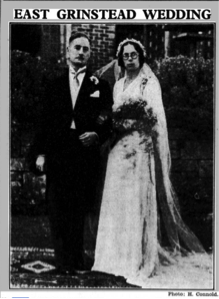
The Burton family have traced her pedigree back to the 13th century Burtons of Rutland, whose members were MPs to Westminster and defended the castles of Cardigan and Aberystwyth against Welsh rebels.
The French connection goes back to Alice’s grandfather, Arthur William Burton, born in Norfolk in 1805, married to Ellen Jones (whose own mother was an O’Brien) and who died in 1884 at 14 Rue Berlioz, 16th arrondissement, Paris, owner of A Burton & Fils, engineers and manufacturers of steam pumps, elevating and conveying appliances, which he had set up in 1855. In 1883 one Edward Meredith Griffiths entered the business in Paris and worked in the drawing office. AWB died in 1884 and in 1886 EM Griffiths until 1891 when he set up in business with Alice’s father Charles W Burton – the Fils of A Burton & Fils – in the firm C W Burton, Griffiths & Co. In 1894 Griffiths became the sole proprietor.
The Griffiths and Burton families stayed close, as Alice and her brothers Charles Frederick Burton and Robert Griffiths Burton were all beneficiaries of E.M. Griffiths’s will – A “Midland Manufacturers Fortune” ran the headline – when he died in October 1933, a few months after our dinner. And we might safely assume that Robert’s second name Griffiths must be after him – Robert was born in 1894, the year E.M. Griffiths took sole ownership. C.W.Burton, Griffiths &Co. had offices in Ludgate Hill, London and Glasgow. A Mrs Griffiths attended Robert Burton’s 1934 wedding, most likely the widow of the recently deceased E.M. Griffiths.




MORE RECOLLECTIONS
Alison Knocker, whose family has portraits – “stunning portraits, in which she seems to access the soul of the sitter ” – painted by Alice Burton, has written to The Dinner Puzzle as follows with wonderful recollections by her husband and by his father – the latter’s remembrances being preserved behind a painting of a rose by Alice:
My husband’s parents met Alice Burton through a friend while they were living in Devon shortly after WW2. His father (Robert Knocker) and the friend (John Little) were both engineer officers in the Royal Navy. At the time Alice was painting the Littles’ children and agreed then to paint his mother (Cicely Elisabeth Knocker) in her studio in 1947. CEK was aged 28; her dress in the portrait was a ‘prop’ supplied by Alice, apparently “gathered together at the back because it had originally been made to fit a women twice as large!” The framed portrait was hung for a period in a Royal Society of Portrait Painters Exhibition, London.
Robert and Elisabeth then asked Alice to paint their eldest daughters, Anne and Prue. This was at Alice’s home, Pightle Cottage, Silverstone, Northants in 1948/49.
A further Alice Burton painting is in the family: “Portrait of a Rose”, painted in 1950. On the back of it is a note penned by my father Robert in 1995, as follows:
“Some 45 years ago during a brief visit one morning to Alice Burton, she decided the light was just right for painting so we walked down to her studio in the village (she had another studio in London). On the way, she picked a rose from a friend’s garden and on arrival put it in a jam jar, hung an old black cardigan behind it as background and spent the next couple or more hours painting it. I sat and watched, helped myself to a g & t and we chatted – in part about her recent visits from HRH The Duke of Gloucester whose portrait she was painting/had painted for the Cavalry Club, London. At about 2pm she decided she had done enough so we walked back to her cottage where I was given lunch of a most excellent vol-au-vent and a bottle of wine of her making from the cellar – Gooseberry, and quite excellent. I think the D of G had had similar meals and was always most loath to leave! “Aunt Al” (she was an older generation than me) asked me if I would like the rose picture? Of course I replied “Yes” PLEASE”. She said when it was fully and properly finished I would get it. Some months later she arrived at our home in Wickham, Hampshire with the painting, framed by the man who did all her framing, and refused to accept one penny for it! It has remained one of my most treasured possessions.
She said that during the war she sent several flower paintings to a friend in USA who sold them and sent her, in return, goods like sugar and other goodies not obtainable in the UK. She added that flower paintings were her ‘5 finger exercises’ which helped her with the painting of complexions of the sitters for a portrait.
Alice Burton, spinster, was the only daughter in a family of 5 or 6 sons and was brought up much as a boy. The family used to go to N. France for summer holidays where they were often joined by Rudyard Kipling, a great friend.”
Wonderful recollections, of finger exercises, vol-au-vent, wine and Kipling. Thank you Alison and family!
RECOLLECTIONS OF A SITTER
Ann Blythe, who sat for Alice in the 1960s, has kindly shared her recollections (images not to be reproduced without permission please):

“My parents commissioned a portrait of me by Alice, around 1963. They had contacted the Royal Society of Portrait Painters asking for a recommendation for an artist who painted realistically and was not ‘modern’! The RSPP highly recommended Alice. We visited her at Pightle Cottage, where I sat for her in her studio. I also have a second portrait of myself by here, painted in 19164, (the first portrait of me was lost).
She and my mother became friends, and Alice wanted to paint her portrait as a gift. When my mother demurred, saying she wasn’t portrait material, Alice said “Dear lady, allow me to be the judge of that…” I have the resulting painting, dated 1967.
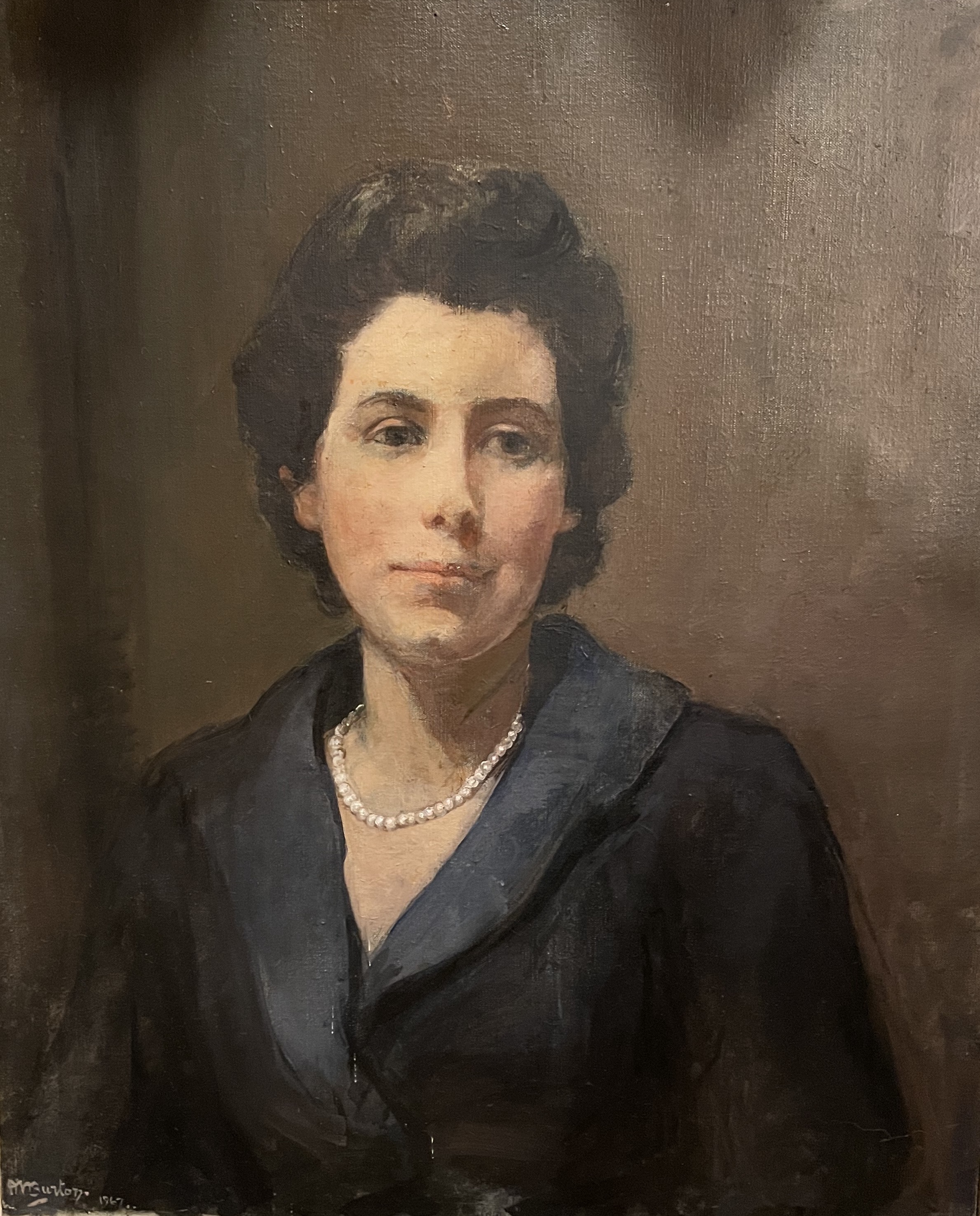
We often visited Pightle Cottage, and not just for sittings. Alice kept hens and bees. Her home smelled of turpentine and beeswax. She mixed her oil paints with egg yolks from her own eggs, and used to let me accompany her to collect them. She had 2 dogs when we knew her: a corgi called Spats (white paws) and a Cairn terrier called Tiny. I have many photos of Alice, her brown hair always in a low bun, wearing her hallmark white shirt and tie, tweedy skirt, thick stockings and sensible shoes. Many of the photos are of her and Spats, doing ‘sit up and beg’ tricks, both in her garden and inside Pightle Cottage. I have one photo of the interior of her studio, which is filled with paintings in various stages of completion.

Ann Blythe and her mother Margaret visiting Alice and her dogs at Pightle Cottage
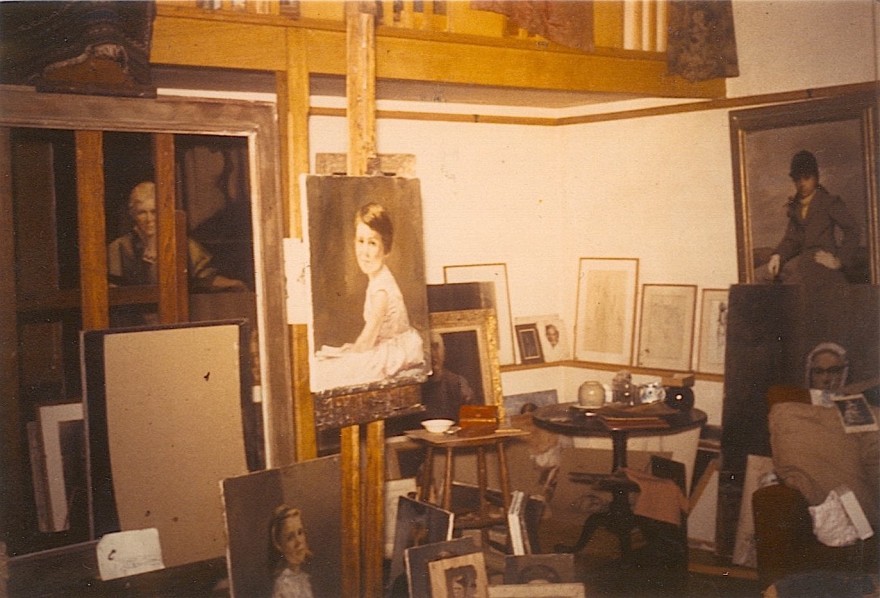
BACK TO TOP TABLE
[1] With many thanks to the nieces and great nieces in Las Vegas and London of Alice Burton for the many images of Alice and her studio on this site. Not to be reproduced without permission.
[2] BBC Report on Portrait Unveiling http://www.bbc.co.uk/news/uk-wales-south-east-wales-15470936
[3] Richard Taylor Fine Art, Alice Mary Burton, accessed 4.1.2018 http://www.richardtaylorfineart.com/artist/alice-mary-burton
[4] Miss Alice Burton, Hutchinson’s Woman’s Who’s Who 1934, Hutchinson & Co. London.
[5] The Daily Express, 23.3.1933 p20, ©Mirrorpix
[6] Note Alice was not born in 1893 as some art dealer pages online suggest.
[7] Art UK, Alice Mary Burton, accessed 4.1.2018 https://artuk.org/discover/artists/burton-alice-mary-18931968
[8] Votes for Women, 29th March 1912 p3
[9] I am indebted to Alastair Adams, PPRP for information on Alice and on the 1924 exhibition: Item No 121, listed p 18 in the catalogue, and No 229 on page 29.
[10] https://en.wikipedia.org/wiki/SS_Berlin_(1894)
[11] Hartlepool Northern Daily Mail, 29.5.1931 p3
[12] Western Mail, 29.9.1931 p9
[13] Private letter Francesca Webber (née Conlon) to Angela V. John, 24.8.2011: many thanks to Angela John for this little gem.
[14] The Daily Express, 23.3.1933 p20, ©Mirrorpix
[15] The Cheltenham Chronicle, 1.7.1933
[16] Alice Mary Burton, Arthur Foley Winnington-Ingram (1858–1946), Bishop of London (1901–1939),The Museum of Fulham Palace
[17] Thank you to Dinner Puzzle contributor Gregor Stone, Australia, for the information on the Unique School and for contacting us with his family information.
[18] Northamptonshire Mercury 1.8.1952
[19] I am also in touch with a descendant in Australia of Anna Maria Burton, sister of Arthur William Burton who set up his business in Paris – she is a “second cousin twice removed” of her eldest brother Charles Frederick, and therefore also of Alice.
[20] Kent & Sussex Courier 19.10.1934 p18 ©Mirrorpix, Image created courtesy British Library Board, Sourced Britishnewspapersarchive.com

Richard Burton, fondly known as Dickie, died in the First World War.
LikeLike
Thank you Juanita. Most appropriately posted today, Armistice Day 2020
Richard
LikeLike
I have a painting by Alice dated 1932 of a woman
LikeLike
We have a painting of my husband’s mother, Cicely Elisabeth Knocker née Hunt, by Alice Burton, probably dated 1944 to 1946. Alice then also painted my husband’s sisters Prue and Anne shortly after the war. They are stunning portraits, in which she seems to access the soul of the sitter.
LikeLike